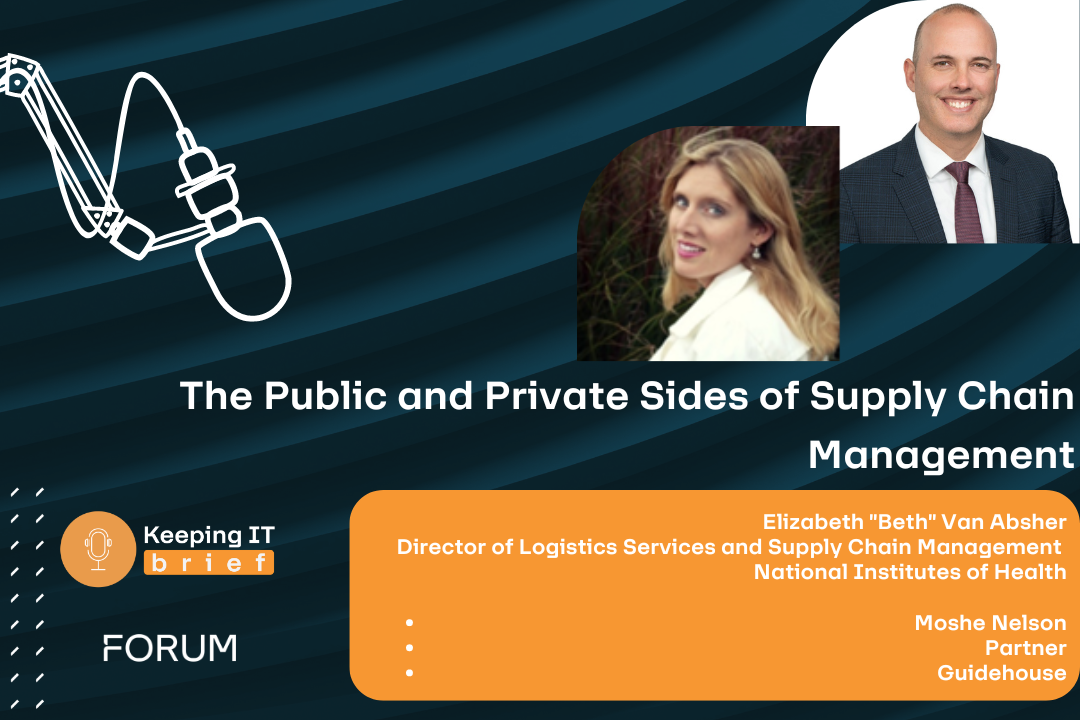This interview with John B Owens II, a Senior Vice President within CGI Federal’s Emerging Technologies Practice, leverages his nine years as CIO at the U.S. Patent and Trademark Office, leading the Agency’s adoption of innovative methods for software development, including Agile and DevOps. In this article, John discusses the role of the Federal CIO; challenges; advice for new CIOs; and advice for industry in supporting the role.
The Role of the Federal CIO
One quote I have heard best describes this role: The CIO is the spear tip of change. The Government uses the CIO and technology to institute change, to bring in new systems, processes and data.
This is an interesting position to be in. To serve as that disruptor driving change, the CIO must build bridges with colleagues, and within industry. This person needs to be able to speak well, be persuasive to get the buy-in necessary to keep change moving in the right direction.
Becoming a Federal CIO
Understanding how people can come into the role of Federal CIO can help industry leaders better position themselves to provide support.
One path involves the Senior Executive Service, or the SES. Through it, you take on more and more growing responsibility within Government, eventually coming into the CIO position. CIOs following this path excel in their understanding of how Government operates but may be challenged in terms of their commercial knowledge in terms of understanding the resources and technology that are available outside the walls of Government, and the typical cost of some of these.
The second path, preferred by some Administrations, is recruiting executives from outside of Government for the fresh perspective and intel they may bring. These CIOs face a different set of challenges when it comes to understanding and accepting the pace of movement within Government. They also may be at a disadvantage in that they must learn who they need to engage within Government, who will be key to supporting their efforts and plans along the way.
Evolution of the Role
The Clinger-Cohen Act of 1996 defined the role of Chief Information Officer as the focal point for IT management within agencies, but the role wasn’t actually confirmed until the e-Government Act of 2002.
In the early days, this role embodied control over all IT assets, data management, information and security; but at that time, that was often for one task, one application. Today, Federal CIOs manage massive projects that bridge organizations and agencies. These projects process terabytes and petabytes of data and, in some cases, serve not only the U.S. but a global community.
Not only has the scope of the role grown exponentially, but the expectations for IT, its capabilities and ease of use, has also grown. CIOs are challenged with modernizing legacy environments and bringing them into the modern standards.
Challenges
Modernizing
Modernizing legacy environments–some decades old–brings to the forefront a number of challenges for CIOs. Not the least of these is ensuring that the backend users of Government systems have the training they need to succeed and the willingness to accept change. Then there is the public, who engage with those applications, and the need to ensure usability and that any transition is seamless.
Large modernization projects need to keep the old systems active while they move to the new. And let’s face it, there aren’t a lot of COBOL programmers around anymore, so that can be tricky. The Federal space has a challenge in finding qualified technical talent, perhaps due to issues of pay flexibility and remote work options compared with industry..
Federal CIOs need to ensure that the people who accept deliverables on behalf of the Government understand the responsibility they are assuming. They need to understand their domains at a very technical level because acceptance in procurement at this level means accepting on behalf of the Government.
Security
Security and privacy of data always bring challenges for CIOs. They need to be built into the system as it is being developed, to ensure that whatever is put into place today can expand in the future without needing to be rewritten.
Many legacy systems were not built for the Internet at all, let alone face the kinds of security attacks and breaches we have seen in recent years and months. Between that and growing concerns over data privacy and protection and ensuring data is used responsibility, security is absolutely a number one concern.
Federal CIOs also serve as security officers, which will occupy a lot of their time. They’ll focus on ensuring their teams have the training they need on the latest security concepts. They’ll need to procure enough money to ensure they can achieve the goals they have set. They also need to balance the way they consider security, thinking through the lens of “Is it secure enough to protect the mission but also open enough to achieve the mission?” The most secure system is completely locked down; but that system is not accessible in achieving forward movement in fulfilling the mission.
Expectations
The expectations between younger generation and experienced employees, Federal workers and external users, differ significantly. CIOs need to find a way to manage the expectations from both sides.
One way to move forward: Start by automating simple work, using low code, no code or code to free people from some of their more repetitive tasks. This can allow them to do more meaningful work, to provide a better user experience, and to present a win that demonstrates the power of some of this potential transformation. Help those Federal employees trigger a different mindset by focusing them on more meaningful work, empowering them to spend their time making decisions, and looking at a broader picture, rather than being tied to manual processes.
As these changes happen, and we bring in new people with an even different view of the world, it will be helpful to document or update process. We have to think of it from that new view however, rather than from the old process-manual mindset of 20 years ago.
Advice for Federal CIOs
As a Federal CIO, you are in the role of a disruptor and must build bridges with colleagues and within industry, because you cannot accomplish all you want and need to do alone.
You must engage your CFO, HR team, general counsel and Chief Procurement Officer. They will help you secure financing, obtain technology and solutions, and identify the right people to help achieve the goal. You will need to figure out who you can trust and who can get you what you need to achieve your goals. If you are coming in from outside Government, part of that starts with understanding how things move through Government; not only the pace, but also how to best engage with those inside and outside of your walls.
Your internal connections will have the experience and the certification to guide you. Their dedication and insight can help you succeed, so it is important to engage them early to guide you and provide options.
You must be able to find the right partners within industry as well, those who understand the mission and can help you achieve the small and consistent wins you will need to demonstrate your progress and to keep change moving forward.
You also need to be a good communicator, because along the way you will need to articulate your needs, and you must convince people that they need the change you are proposing and that it makes sense. People can only absorb so much change and the Federal Government, as an entity, changes slowly.
As a Federal CIO, you will face a daunting level of the highest inspection — between the Office of the Inspector General, justifications, Congress and others. Ensuring you have everything in alignment, partners you can trust, and from the start, engage with the right people in the agency, can make this a lot easier.
Advice to Industry
Industry needs to understand the CIO, their problems, what they need to accomplish. They need to always think about security from the view of what could stop progress or cause problems, and about maintaining a high level of quality. Even if you don’t know have all the answers for these challenges, you won’t be negatively judged by reaching out to the CIO with questions. In fact, discussing your concerns and interest might show the CIO that you are genuine in helping them succeed.
Industry needs to bring innovative solutions that also will provide quick wins. The CIO always looks to understand which horse they can bet on to win the race. That partner will be able to meet the needs of the agency, within budget, and will be able to deliver meaningful results more often than not; the winning partner who brings a solution that can deliver 80% of what the CIO needs. Most CIOs realize they can’t get everything on their wish list, but if they can get that 80%, that is a win.
Many companies approach Government with a generic pitch—those who are successful avoid that. Instead, they will customize an approach that shows they understand the agency’s specific mission and focus, and they will bring real-life examples to showcase what they have done and how they did it. They will point to a similar example of a success that Government wants to achieve, and they will be able to explain their competitive advantage.
CIOs want to be able to build on success – taking their past success to achieve future success with a new partner. If Government engages with someone and they can’t succeed the first time, or don’t achieve at least 80% success, chances are they won’t be a partner the next time around.
My best advice to industry? Be fair, be reasonable, understand that your agency does have a controlled budget, work to fit within their framework, and then deliver what you promised. Those who demonstrate they can meet the goals in the right way will continue to grow and succeed.
About John B Owens II
 John B Owens II is a vice president with CGI Federal’s Emerging Technologies Practice. Prior to joining CGI in 2017, Owens spent nine years as CIO at the U.S. Patent and Trademark Office, leading the agency’s adoption of innovative methods for software development, including agile and DevOps. These efforts resulted in citizen-centric, user-friendly IT solutions and helped the agency accelerate its reactions to the demands of a rapidly changing technology marketplace.
John B Owens II is a vice president with CGI Federal’s Emerging Technologies Practice. Prior to joining CGI in 2017, Owens spent nine years as CIO at the U.S. Patent and Trademark Office, leading the agency’s adoption of innovative methods for software development, including agile and DevOps. These efforts resulted in citizen-centric, user-friendly IT solutions and helped the agency accelerate its reactions to the demands of a rapidly changing technology marketplace.












